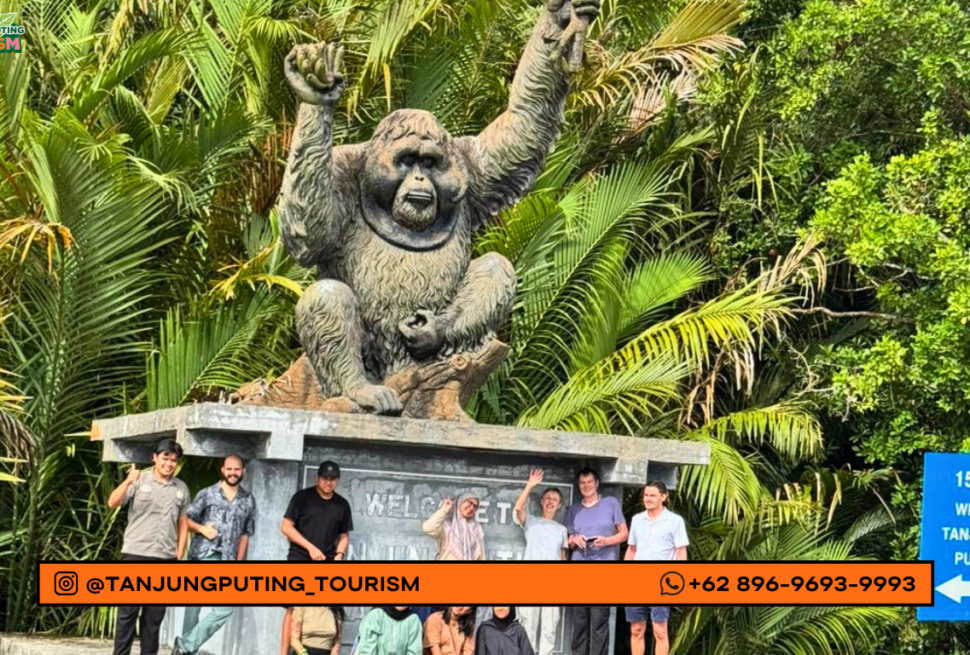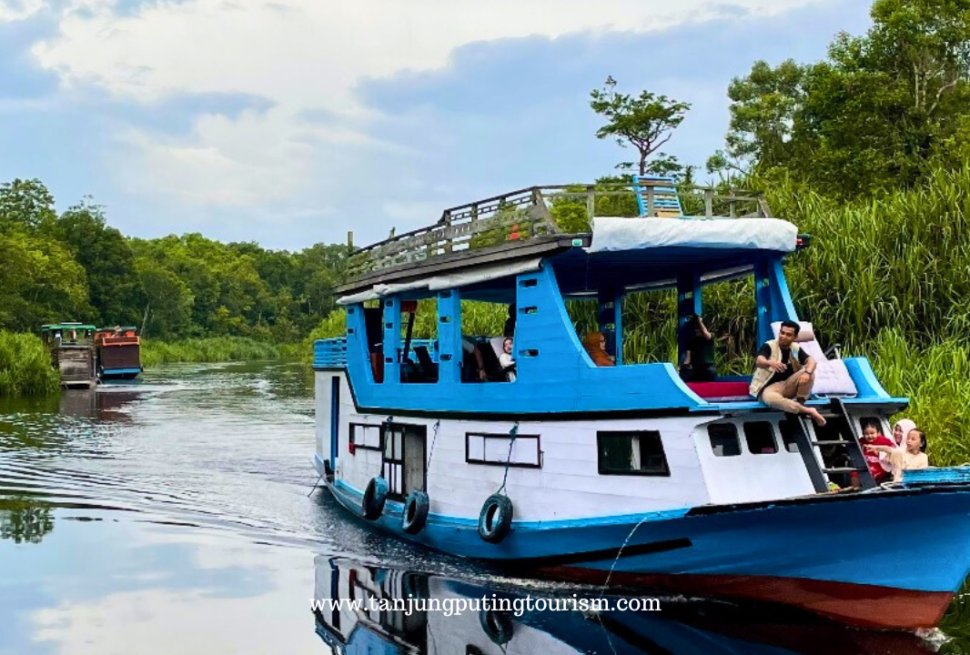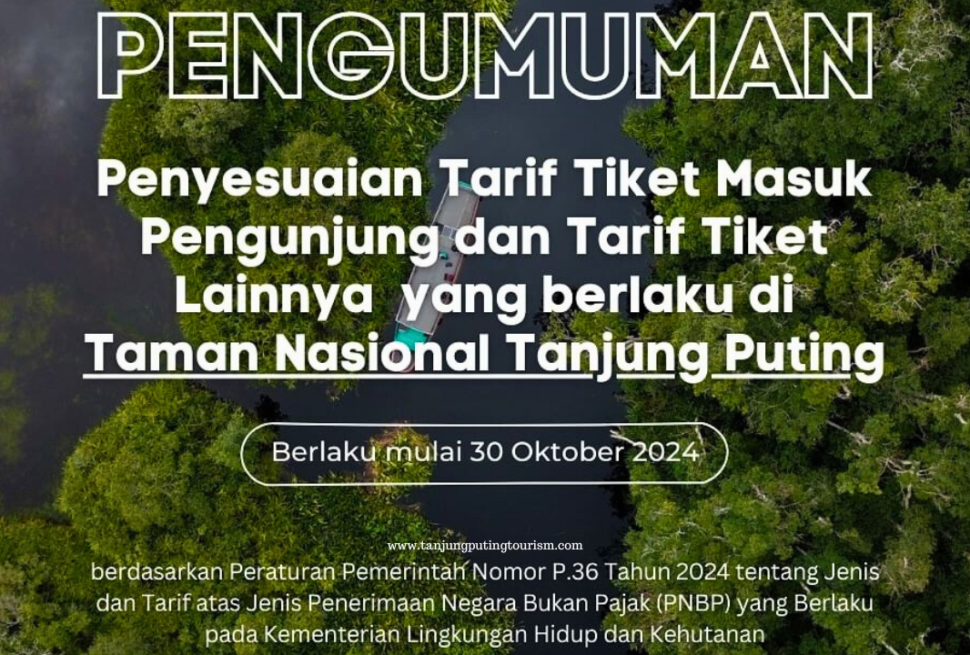If you want to see orangutans in Borneo, one of the best places to do it is at the Tanjung Puting National Park in Kalimantan, Indonesia. The jungle at Tanjung Puting is home to hundreds of Borneo’s animal species, including some rare and endemic ones, and you get to see all of this while staying on a ‘Klotok’ houseboat as it winds along the Sekonyer river. This travel guide will explain how to get to Tanjung Puting and see the orangutans, which boat tour company to use, and everything else you need to know before you go!

How To Get To Tanjung Puting National Park
Tanjung Puting is located on Borneo island, in the Central Kalimantan province of Indonesia, and if you look at it on a map it’s actually on the southern tip of the island. The nearest town and airport is Pangkalan Bun (PKN), and there are direct flights every day from Jakarta, Surabaya, and Semarang. If you’re coming to Tanjung Puting from Bali, then you’ll have to transit in one of those airports on the way to Pangkalan Bun.
River Boat Cruise: What To Expect
Tanjung Puting is normally accessed by boat via the Sekonyer river, and this is done with an all-inclusive liveaboard boat called a ‘Klotok,’ which usually has a crew of at least 4 people: a boat captain, a deckhand, a tour guide, and a cook. The river moves very slowly, so you don’t have to worry about seasickness, rapids, waves, or anything like that on your journey into the park. Besides enjoying the wonderful views from the boat, you’ll also make several stops to get off the boat and go see animals in the jungle, which involves a bit of short, flat trekking. The Klotok boats usually have space for up to 8 people in total, with the guests staying on the upper level while the crew lives in the bottom level.
Meals are provided every day on the boat, and the food in experience was great, including tempeh, omelets, toast, pancakes, fish, chicken, rice, noodles, soup, and all kinds of fruit and veggies. Some Klotok boats have A/C, but most do not, and it’s not really needed. You may be hot and sweaty during the day, but at night the temperatures drop and it’s easy to cool off with a cold shower before bed. Electricity is by generator in the evenings, so we were able to use the outlets to charge our phones and other electronics from time to time. It’s still a good idea to bring a fat power bank, though. The boats have good rain covers so you don’t have to worry about getting wet either. Tours at Tanjung Puting typically last 2 or 3 days, but you can stay longer if you have the time and budget, or you can visit on a 1 day trip with a speedboat if you’re in a hurry.
Complete Package Private Trip Tanjung Puting
Day 1 : Tanjung Harapan
After about 2 hours of traveling along the river by Klotok boat, the first place you’ll stop and visit in the national park is a camp called Tanjung Harapan.
This used to be a rehab center for orphaned and rescued orangutans, but now it’s just a feeding station where they help the animals get supplemental food (mainly fruit) so they can thrive and stay healthy.
When it’s feeding time, the park staff puts a pile of fruit on a wooden platform and then calls the orangutans out of the jungle. Sometimes you have to wait a bit for them to show up, but then they come swinging through the trees and you can watch them eat while you stand behind a fence about 30 meters back.
Night Treking
At the end of your first day in Tanjung Puting, you normally have the option to do night trekking so you can see animals, plants, and bugs in the jungle near Tanjung Harapan.
In just an hour of flat and easy trekking, you saw a tarantula, pit viper, tree frogs, kingfishers, tokays, glow in the dark mushrooms, and lots of other interesting things.
The night trek is optional with most tours, but I’d highly recommend doing it if you still have energy left over at the end of the day!
Day 2: Pondok Tanggui
On second day in Tanjung Puting, the boat another 1.5 hours up the river to get to the next camp, which is called Pondok Tanggui.
Along the way, yousaw some more wildlife in the trees, including proboscis monkeys, a crested serpent eagle, and a black-and-red broadbill.
You got to the camp just before feeding time, which starts at 9 AM. This time, we saw even more orangutans, including one very big and photogenic male orangutan who came at the end of the feeding time.
It was a good reminder to stay and wait a little bit after the feeding time ends, because sometimes the best animal sightings happen when the tourists have already started to leave.
Camp Leakey
After left Pondok Tanggui and got back on the river, the boat ride took approximately 2 hours to get to our next stop, which was Camp Leakey. The feeding time there is at 2 PM.
The color of the river at this point turns black because of chemicals from the plants, and the surface of the water is almost like a mirror reflecting the swamp. It looks spooky and beautiful.
At Camp Leakey, your saw another dozen orangutans, but the highlight this time was seeing several mothers carrying babies.
The lighting and photo ops at this camp seem to be the best since the jungle isn’t quite as dense and dark as the first two camps.
After taking hundreds of orangutan photos, you went back to the boat and started the return journey to Kumai and Pangkalan Bun, stopping several times along the way to see more animals on the riverbanks.
Your spotted lots of blue kingfisher birds and several families of proboscis monkeys, including a mother with a baby. Your drove most of the way back to town and then spent our second night near the entrance to the Sekonyer river, where there were lots of fireflies flickering in the palm trees. It looked kind of like blinking Christmas trees.
Day 3: Return To Pangkalan Bun
On day 3, your enjoyed a sunrise on the river and then ate breakfast before traveling approximately 1 hour back to the Kumai port, where your also had the option to visit a traditional Dayak longhouse near Pangkalan Bun. This concluded tour. Tanjung Puting was a wonderful trip filled with many memories.




